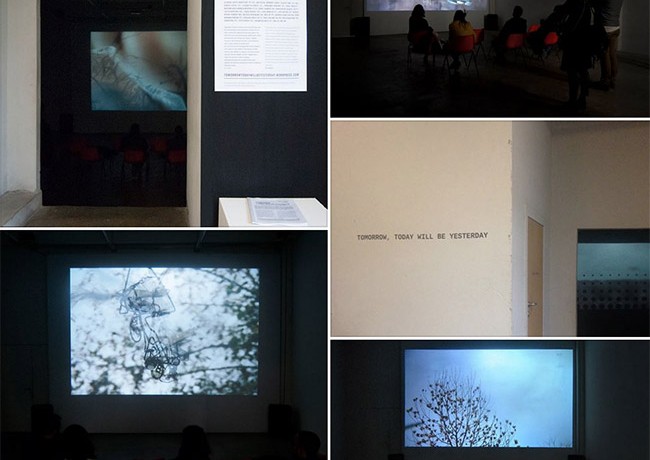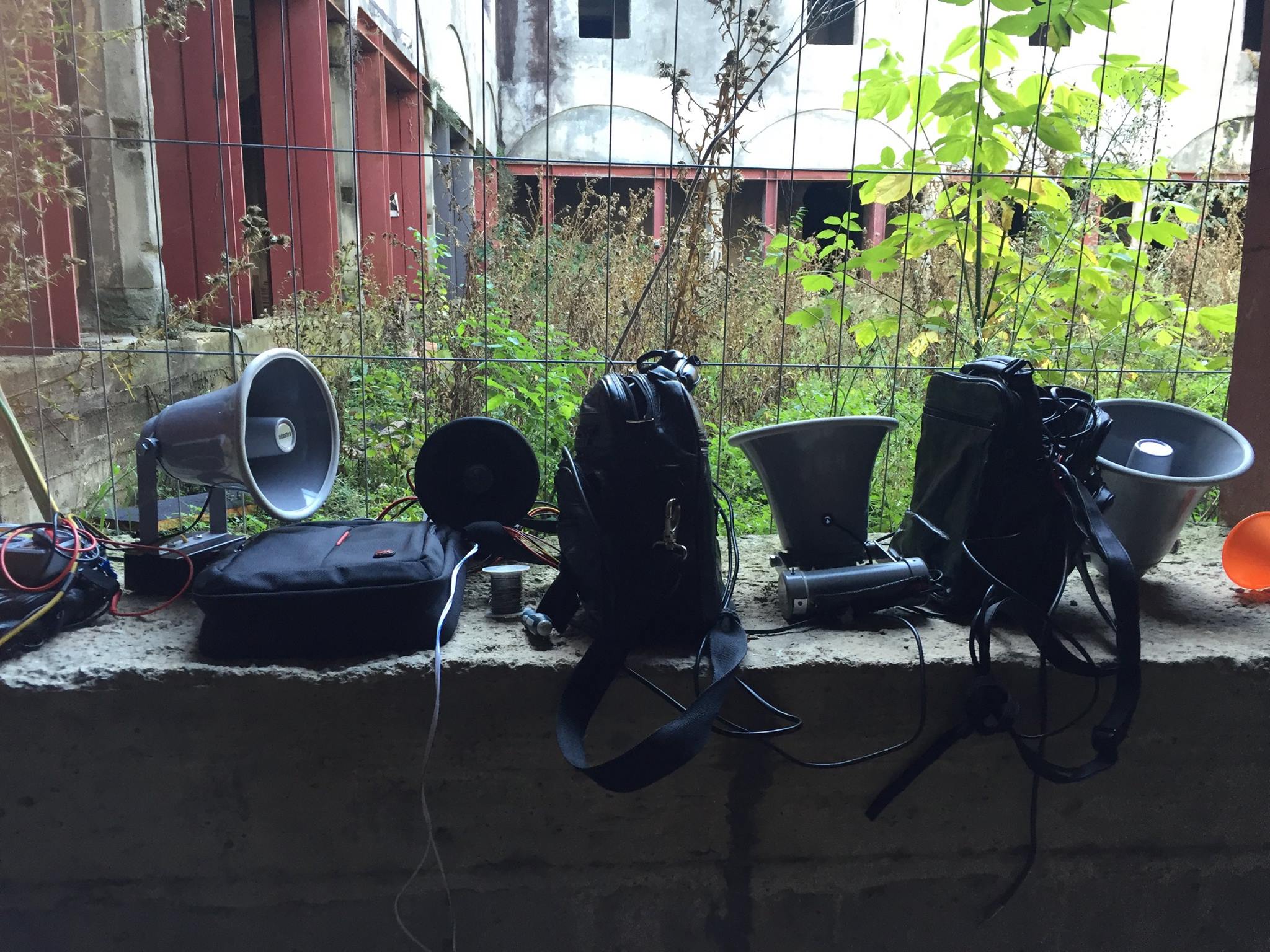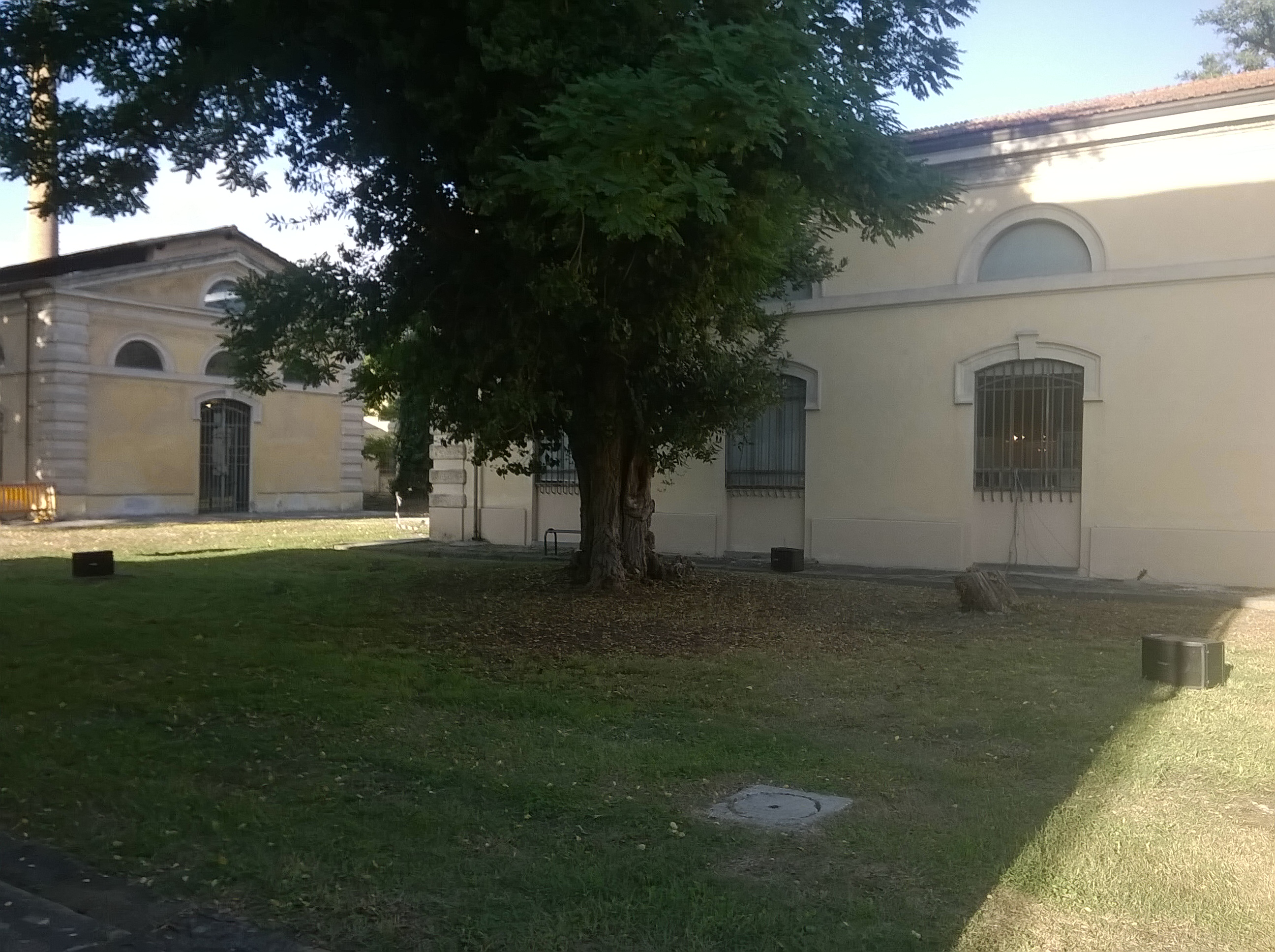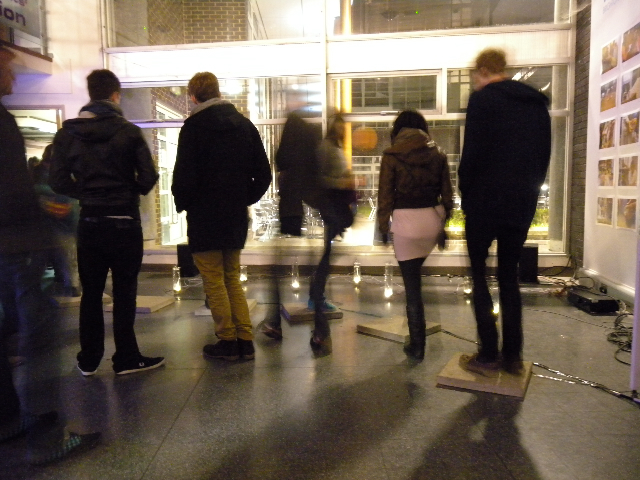

 At the end of year 2016 I was artist-in-residency for ten days in the small town of Foligno (PG) where I presented a sound intervention for the spaces of the ex-church Auditorium Santa Caterina. The project explores practice of field recording as critical approach to public places and listening spaces. I focused on historical and anthropological sounds/noises gathered after long and accurate soundwalking activity within the city center of Foligno. At the end of the residency I achieved an interactive indoor sonic piece for the foyer space where boundaries of performance, installation and play are trangsressed. Through an analogic/electronic system I developed and built, audience activates sounding objects/materials spread out on the floor of the ex-church. It has been used long wires of vibration sensors/piezos, a 6.1 multi-channel speakers system and a real-time programming language for monitoring the entire interaction.
At the end of year 2016 I was artist-in-residency for ten days in the small town of Foligno (PG) where I presented a sound intervention for the spaces of the ex-church Auditorium Santa Caterina. The project explores practice of field recording as critical approach to public places and listening spaces. I focused on historical and anthropological sounds/noises gathered after long and accurate soundwalking activity within the city center of Foligno. At the end of the residency I achieved an interactive indoor sonic piece for the foyer space where boundaries of performance, installation and play are trangsressed. Through an analogic/electronic system I developed and built, audience activates sounding objects/materials spread out on the floor of the ex-church. It has been used long wires of vibration sensors/piezos, a 6.1 multi-channel speakers system and a real-time programming language for monitoring the entire interaction.
Limbus #02 is the result of an art residency programme I experienced in Foligno (PG) with the support of two italian cultural instituions. I presented an interactive sonic piece for the empty spaces of the ex-church Santa Caterina by working on everyday sounds/noises gathered from this historical roman town placed at the very center of Italy. The project explores concepts of space, sense of place and contextual listening. Through a monitored analogic/electronic system made of vibration sensors field recordings and a real-time programming language, visitors actively engage with sounding surfaces/objects and non-linear soundscape composition. Recorded live at Performing Santa Caterina on 18th November 2016 at Ex-Church Auditorium Santa Caterina Foligno (Perugia) - ITALY
 Acoustic performance in the abandoned spaces of of Sant'Orsola. We resonated with DIY electronic instruments. The performance event is the result of an intensive workshop held by the sound artist Matteo Marangoni iii (instrument
inventors initiative) based in Den Haag (NL) for Sonic Somatic 2016 in collaboration with Tempo Reale (IT). 'City Sondols offers temporary appropriation’s strategies in urban and architectonical spaces. These are transformed in set designs for sound and aesthetic rituals where the borders between protest, game and sensorial exploration are blurring. The public is invited to experience such an evocative place of the city both physically and acoustically'.
Conductor: Matteo Marangoni Performers: Monica Belloni, Matteo Coluccia, Anna Maria Di Giacomo, Nicola
Giannini, Andrea Lulli, Valerio Orlandini, Francesco Perissi, Elisabetta Senesi.
Acoustic performance in the abandoned spaces of of Sant'Orsola. We resonated with DIY electronic instruments. The performance event is the result of an intensive workshop held by the sound artist Matteo Marangoni iii (instrument
inventors initiative) based in Den Haag (NL) for Sonic Somatic 2016 in collaboration with Tempo Reale (IT). 'City Sondols offers temporary appropriation’s strategies in urban and architectonical spaces. These are transformed in set designs for sound and aesthetic rituals where the borders between protest, game and sensorial exploration are blurring. The public is invited to experience such an evocative place of the city both physically and acoustically'.
Conductor: Matteo Marangoni Performers: Monica Belloni, Matteo Coluccia, Anna Maria Di Giacomo, Nicola
Giannini, Andrea Lulli, Valerio Orlandini, Francesco Perissi, Elisabetta Senesi.

Installation view of this collective sound/video art exhibition. All the details here
The project presents an interactive, spatial sound installation based on audio listening, field recordings and physical computing. It is composed by five acoustic found objects/materials and deals with concept of curiosity, sociality and proximity. The repetition, the transmission and the temporality of sounds/noises we experience and inhabit in our three-dimensional world. The piece is a location-based sonic intervention where sourced architectural objects/materials are being used as instruments of physical interaction and sonic transmission. There is no beginning or end, yet a continuous non-linear sonic ON/OFF aiming to create a space for exploration and play by actively engaging visitors in the co-creation of the work. Each object/material stores a specific pre-recorded sound/noise. Essentialy people peak up the sound by touching them, separately. Audience is invited to explore the space around and listening. Each action/interaction actionates and playbacks the sound/noise for a certain period of time depending on the scale of vibration. An analog-digital system I have designed monitors in real-time the entire progression of the performative event.


Please check here my research paper published by Springer Verlag, October 2016

In this installation I presented a listening station where three sound pieces are playbacked one after another in loop.
Tracks esplore sense of space, journey and voice.


An installation view of Noise Calm Zone installed and projected in the old castle.

A Drive-in Audiopark is a form of easy listening consisting of an outdoor parking place for automobiles with a station that is transmitting the various sound channels. Within this enclosed area, customers can listen the sound piece from the privacy and comfort of their own cars or special vehicles that are lined up for this purpose. The sound can be provided by an individual speaker hung from the window of each car, which would be attached by a wire, or can be heard as simple as through the speaker of the car radio.


My sound piece 378Km Capisci Amore Mio is installed in the blue and red van. People go in and listen. During the PNEM Sound Art Festival 2014, this system is superseded by the more economical and less damage-prone method of broadcasting the soundtrack at a low output power on FM radio to be picked up by any car radio in the neighborhood. This method also allows the soundtrack to be picked up in stereo by the audience on an often high-fidelity stereo installed in the car instead of through a simple speaker.


Among its advantages is the fact that a family with a baby od dog can take care of this while listening the music, while teenagers with access to autos find drive-ins ideal for dates. Revenue is not limited like regular drive-in cinemas where showings can only begin at twilight.

A Drive-in Audiopark has the following advantages:
• Concert selection by car is possible via FM-frequency, CD or Mp3 player.
• More privacy for the listener inside the cars.
• The volume can be controlled by the listener itself.
• Babies or dogs can taken without disturbing other visitors.
• One can talk and eat without disturbing others.
• There may be even be smoked inside the own car.
• More room to stretch out to lie down while listening.




Audiomagma is a small scale installation, partly interactive, based on field recordings and photographs I am gathering in a very first stage of the MPhil/PhD in Sonic Arts at Goldsmiths College, University London. Using contact microphones as sensors for physical interaction and a real-time graphical dataflow programming environment for monitorization, people activate the pre-recorded sounds/noises by touching several concrete objects. Meanwhile, a projection of photographs regarding a ‘visual space of sound’ runs on a screen. Thus, I present a work in progress project for sharing my concerns towards new ‘forms of listening’ and live interactions with the built environment. My aim is to explore sound in public space and how that sound is deployed in that space. As sensation is fundamental to our experience of the world, I am rather concerned with the nature of perception and the role of the senses in society.



Photos documenting a performance event at Errant Bodies Space where Iintervened in the footpath area by attaching contact microphones on the bike railing, on a pot and several objects/materials I find in the given space willing to transmit pre-recorded sounds/noises for creating a physical/behavioural interaction/situation for visitors.


During the performance event I am in the celler for monitoring the whole system and for mixing field recordings every half hour through a programming language I have designed. There are in total four speakers, one in the pavement outdoor and indoor, one in the cellar and another one in the corridor next to it.


Photos documenting an outdoor interactive installation at the garden
of the University of Brighton where I used a sourced architectural object (a
steel railing above a bike ramp) as an instrument of interaction for engaging
audiences in exploring the sonic dimension of experience around the fences by
touching and listening. People detect and tune the sounds/noises on by physical
transmission through a monitored electronic system I have designed. There are
two big loudspeakers on the grass and sensors attached to the acoustic railings
which stores an overlapping quantity of pre-recorded and thought-provoking
sounds/noises I have gathered from different public sites. >>>>>>>>>>>>>>>>>>>>>>>>>>>>>>>>>>>>>>>>>>>>>>>>>>>>>>>>>>>>>>>>>>>>>>>>>>>>>>>>>>>>>>>>>>>>>>>>>>>>>>>>>>>>>>>>>>>>>>>>>
Sonic GaRden Oxford 2010

LimbuS #01 Brighton 2010
